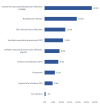Pattern and Frequency of Nosocomial Infections in the Pediatric Intensive Care Unit at East Jeddah General Hospital, Saudi Arabia
- PMID: 38021580
- PMCID: PMC10666072
- DOI: 10.7759/cureus.47561
Pattern and Frequency of Nosocomial Infections in the Pediatric Intensive Care Unit at East Jeddah General Hospital, Saudi Arabia
Abstract
Background Because of the use of invasive devices and procedures in critically sick patients, patients in the pediatric intensive care unit (PICU) are particularly vulnerable to nosocomial infections. Although a significant illness may necessitate admission to the PICU, infections can also emerge after admission. Nosocomial infection is a major public health issue related to increased morbidity, death, and healthcare costs. This study aimed to determine the pattern, frequency, and outcomes of nosocomial infections among children who were admitted to the PICU. Methodology This retrospective, cross-sectional study was conducted in the pediatric population aged from one month to 14 years old who acquired infections after 48 hours of admission to the PICU at East Jeddah General Hospital, Saudi Arabia from 2021 to 2022. The data were collected from medical and laboratory records. Results A total of 51 patients developed 145 nosocomial infections. Central line-associated bloodstream infections (CLABSIs) were the most commonly reported type of nosocomial infections (28.3%). The majority of the isolated organisms (58.7%) were gram-negative, followed by fungal infections (35.1%) and gram-positive organisms (6.2%). The death rate for patients with nosocomial infections was 29.4%. Increased death rates among individuals with CLABSIs and gram-negative isolates were observed to be significantly correlated (p = 0.001). Conclusions Our findings suggest that regular surveillance systems were necessary to assess the relationship between these well-known risk variables with PICU, implying that preventing these infections through particular treatments could be cost-effective and contribute to the safety of healthcare systems.
Keywords: cauti; clabsi; nosocomial infection; pediatric intensive care unit (picu); saudi arabia; sepsis; vap.
Copyright © 2023, Almazeedi et al.
Conflict of interest statement
The authors have declared that no competing interests exist.
Figures



Similar articles
-
Rate, risk factors and outcomes of catheter-related bloodstream infection in a paediatric intensive care unit in Saudi Arabia.J Hosp Infect. 2006 Feb;62(2):207-13. doi: 10.1016/j.jhin.2005.06.032. Epub 2005 Nov 22. J Hosp Infect. 2006. PMID: 16307822
-
Rate, risk factors, and outcomes of nosocomial primary bloodstream infection in pediatric intensive care unit patients.Pediatrics. 2002 Sep;110(3):481-5. doi: 10.1542/peds.110.3.481. Pediatrics. 2002. PMID: 12205248
-
Attributable cost of nosocomial primary bloodstream infection in pediatric intensive care unit patients.Pediatrics. 2005 Apr;115(4):868-72. doi: 10.1542/peds.2004-0256. Pediatrics. 2005. PMID: 15805357
-
Epidemiology of pediatric sepsis in the pediatric intensive care unit of king Abdulaziz Medical City, Jeddah, Saudi Arabia.BMC Pediatr. 2021 May 7;21(1):222. doi: 10.1186/s12887-021-02686-0. BMC Pediatr. 2021. PMID: 33962589 Free PMC article.
-
Microbiologic spectrum and susceptibility pattern of clinical isolates from the pediatric intensive care unit in a single medical center - 6 years' experience.J Microbiol Immunol Infect. 2009 Apr;42(2):160-5. J Microbiol Immunol Infect. 2009. PMID: 19597649 Review.
References
-
- Surveillance of nosocomial infections at a Saudi Arabian military hospital for a one-year period. Abdel-Fattah MM. https://www.ncbi.nlm.nih.gov/pmc/articles/PMC2703250/ Ger Med Sci. 2005;3:0. - PMC - PubMed
-
- Rate, risk factors and outcomes of catheter-related bloodstream infection in a paediatric intensive care unit in Saudi Arabia. Almuneef MA, Memish ZA, Balkhy HH, Hijazi O, Cunningham G, Francis C. J Hosp Infect. 2006;62:207–213. - PubMed
-
- Nosocomial infections in the pediatric intensive care units in Lithuania. Asembergiene J, Gurskis V, Kevalas R, Valinteliene R. https://pubmed.ncbi.nlm.nih.gov/19223703/ Medicina (Kaunas) 2009;45:29–36. - PubMed
-
- Hospital acquired pneumonia in critically ill children: incidence, risk factors, outcome and diagnosis with insight on the novel diagnostic technique of multiplex polymerase chain reaction. Mansour E, Bendary S. Egypt J Med Human Genet. 2012;13:99–105.
LinkOut - more resources
Full Text Sources
